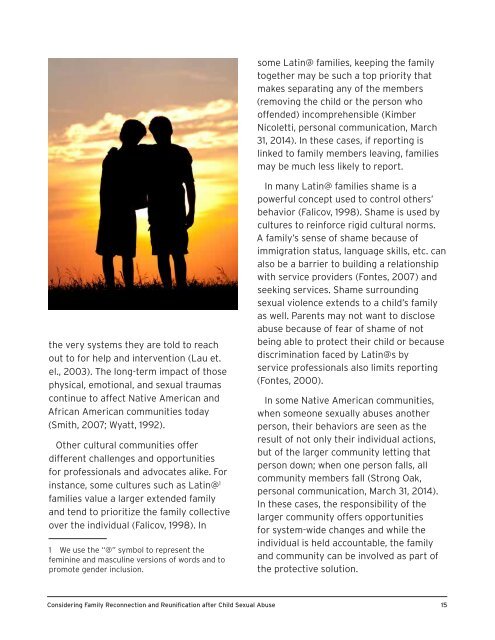Considering Family Reconnection and Reunification after Child Sexual Abuse
1VwGeds
1VwGeds
Create successful ePaper yourself
Turn your PDF publications into a flip-book with our unique Google optimized e-Paper software.
some Latin@ families, keeping the family<br />
together may be such a top priority that<br />
makes separating any of the members<br />
(removing the child or the person who<br />
offended) incomprehensible (Kimber<br />
Nicoletti, personal communication, March<br />
31, 2014). In these cases, if reporting is<br />
linked to family members leaving, families<br />
may be much less likely to report.<br />
the very systems they are told to reach<br />
out to for help <strong>and</strong> intervention (Lau et.<br />
el., 2003). The long-term impact of those<br />
physical, emotional, <strong>and</strong> sexual traumas<br />
continue to affect Native American <strong>and</strong><br />
African American communities today<br />
(Smith, 2007; Wyatt, 1992).<br />
Other cultural communities offer<br />
different challenges <strong>and</strong> opportunities<br />
for professionals <strong>and</strong> advocates alike. For<br />
instance, some cultures such as Latin@ 1<br />
families value a larger extended family<br />
<strong>and</strong> tend to prioritize the family collective<br />
over the individual (Falicov, 1998). In<br />
1 We use the “@” symbol to represent the<br />
feminine <strong>and</strong> masculine versions of words <strong>and</strong> to<br />
promote gender inclusion.<br />
In many Latin@ families shame is a<br />
powerful concept used to control others’<br />
behavior (Falicov, 1998). Shame is used by<br />
cultures to reinforce rigid cultural norms.<br />
A family’s sense of shame because of<br />
immigration status, language skills, etc. can<br />
also be a barrier to building a relationship<br />
with service providers (Fontes, 2007) <strong>and</strong><br />
seeking services. Shame surrounding<br />
sexual violence extends to a child’s family<br />
as well. Parents may not want to disclose<br />
abuse because of fear of shame of not<br />
being able to protect their child or because<br />
discrimination faced by Latin@s by<br />
service professionals also limits reporting<br />
(Fontes, 2000).<br />
In some Native American communities,<br />
when someone sexually abuses another<br />
person, their behaviors are seen as the<br />
result of not only their individual actions,<br />
but of the larger community letting that<br />
person down; when one person falls, all<br />
community members fall (Strong Oak,<br />
personal communication, March 31, 2014).<br />
In these cases, the responsibility of the<br />
larger community offers opportunities<br />
for system-wide changes <strong>and</strong> while the<br />
individual is held accountable, the family<br />
<strong>and</strong> community can be involved as part of<br />
the protective solution.<br />
<strong>Considering</strong> <strong>Family</strong> <strong>Reconnection</strong> <strong>and</strong> <strong>Reunification</strong> <strong>after</strong> <strong>Child</strong> <strong>Sexual</strong> <strong>Abuse</strong> 15


